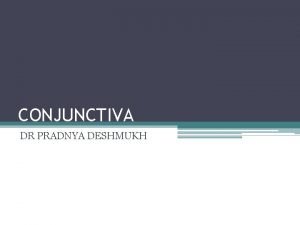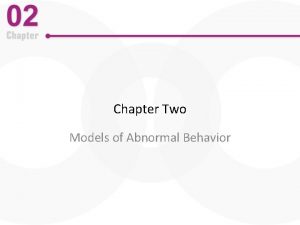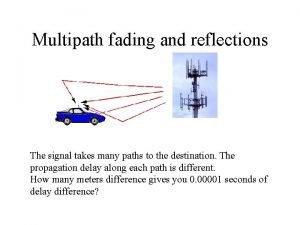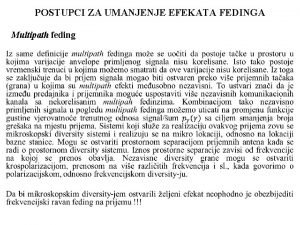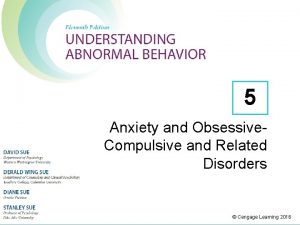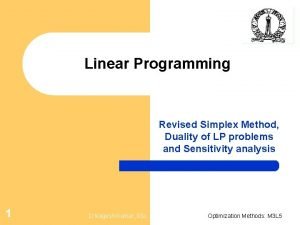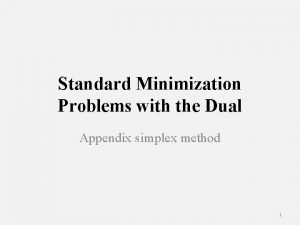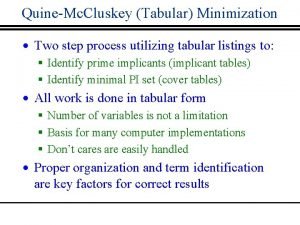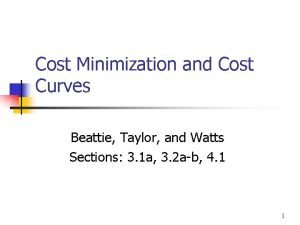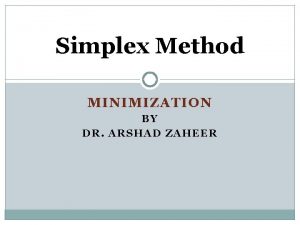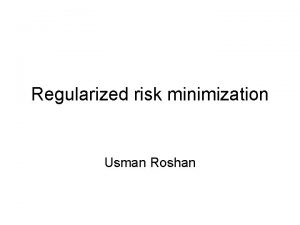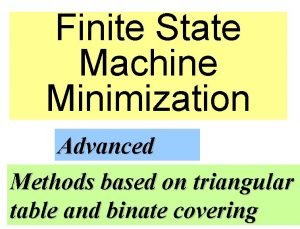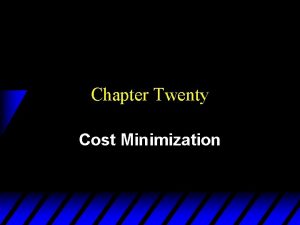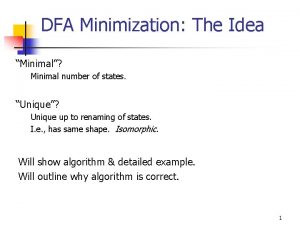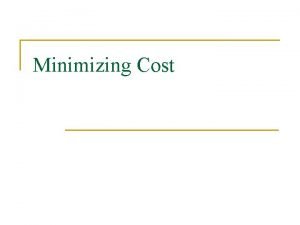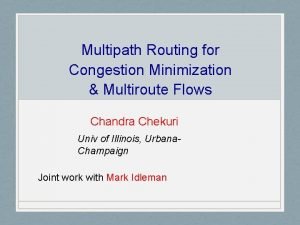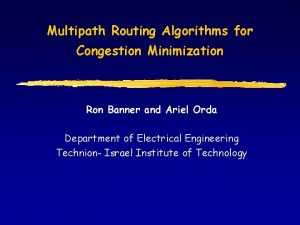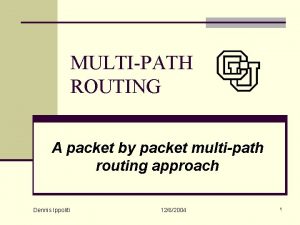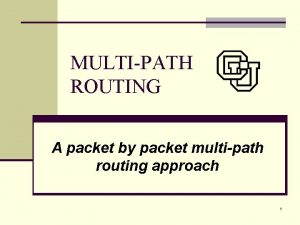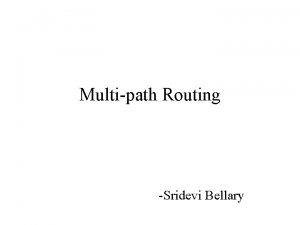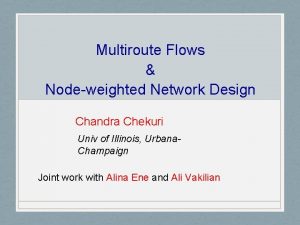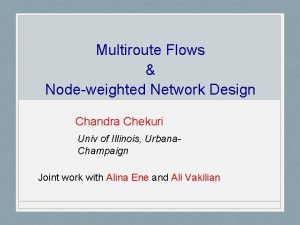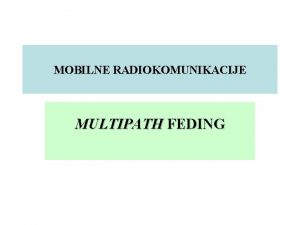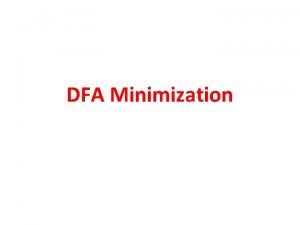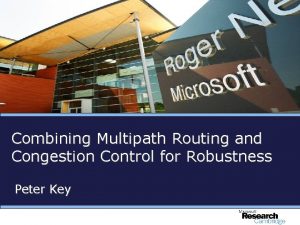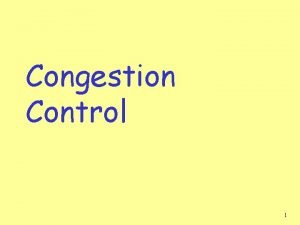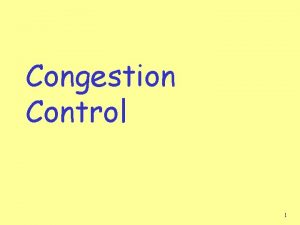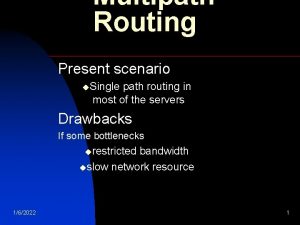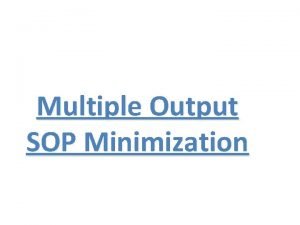Multipath Routing for Congestion Minimization Multiroute Flows Chandra





![Multiroute flows: basic theorem [Kishimoto, Aggarwal-Orlin] Theorem: An acyclic edge s-t flow x : Multiroute flows: basic theorem [Kishimoto, Aggarwal-Orlin] Theorem: An acyclic edge s-t flow x :](https://slidetodoc.com/presentation_image_h2/ffd5d1a86a3fe180a96a0f868399d7c9/image-6.jpg)















- Slides: 21

Multipath Routing for Congestion Minimization & Multiroute Flows Chandra Chekuri Univ of Illinois, Urbana. Champaign Joint work with Mark Idleman

s-t flows in directed graphs •

Flow Decomposition • Edge flow f of value v can be decomposed into a path flow in O(nm) time • A path flow of value v induces an edge flow of same value

Multi-route flows �� (st) = { p | p is a st path } �� (st, h) = {p = (p 1, p 2, . . . , ph) | each pj ∈ �� (st) and the paths are edge-disjoint } h-route s-t flow f : �� (st, h) → R+ f(p) flow on path-tuple p

s p q t
![Multiroute flows basic theorem Kishimoto AggarwalOrlin Theorem An acyclic edge st flow x Multiroute flows: basic theorem [Kishimoto, Aggarwal-Orlin] Theorem: An acyclic edge s-t flow x :](https://slidetodoc.com/presentation_image_h2/ffd5d1a86a3fe180a96a0f868399d7c9/image-6.jpg)
Multiroute flows: basic theorem [Kishimoto, Aggarwal-Orlin] Theorem: An acyclic edge s-t flow x : E → R+ with value v can be decomposed into a h-route flow iff x(e) ≤ v/h for all edges e 3 s 1 2 t 1 s 1 t 1

Congestion Minimization t 3 s 2 Choose a path for each pair t 1 Minimize max number of paths using any edge (congestion) G s 1 s 3 t 2

Congestion Minimization s 2 G t 3 0. 7 0. 5 0. 25 0. 1 0. 3 Choose a path for each pair t 1 Minimize max number of paths 0. 15 using any edge (congestion) Special case: Edge-Disjoint Paths s 1 0. 2 s 3 0. 15 0. 65 t 2 [Raghavan-Thompson’ 87] • Solve mc-flow relaxation (LP) • Randomly pick a path according to fractional solution • Chernoff bounds to show approx ratio of O(log n/log n)

Multipath Routing h 2 = 1 s 2 t 3 t 1 G Choose hi paths for pair (si, ti) (assume paths for pair disjoint) Minimize max number of paths using any edge (congestion) h 1 = 2 s 1 t 2 s 3 h 3 = 2

Multipath Routing s 2 G t 3 0. 7 0. 5 0. 3 0. 25 0. 3 s 1 0. 7 s 3 0. 5 0. 8 t 2 t 1 0. 95 Choose hi paths for pair (si, ti) (assume paths for pair disjoint) Minimize max number of paths using any edge (congestion) [Srinivasan’ 99] • Solve relaxation (LP) • Dependent rounding • O(log n/log n) approx via negative correlation

Can use multiroute flow decomposition • Decompose for each pair flow into hi-route flow of value 1 • Do independent rounding ala Raghavan. Thompson 0. 5 0. 3 s 1 t 1 0. 25 0. 95 0. 25 0. 05

Advantages • Rounding and analysis exactly the same as it is for standard congestion minimization. No need for technicalities of dependent rounding. • If paths are short can use Lovasz-Local-Lemma to reduce congestion to O(log d/log d) where d is max # of edges in any path collection of decomposition (via existing results of [Srinivasan, Moser-Tardos, Haeupler-Saha-Srinivasan])

Choosing Paths • G=(V, E) , (s 1, t 1), …, (sk, tk) and need hi edgedisjoint paths per pair • Minimize congestion

Multi-route flow LP Min C p ∈ P(siti, h) f(p) ≥ 1 for all (si, ti) p ∈ P(siti, h) : e ∈ p f(p) ≤ C f(p) ≥ 0 for all p for all e, i

Multi-route flow LP Min C p ∈ P(siti, hi) f(p) ≥ 1 for all (si, ti) p ∈ P(siti, hi) : e ∈ p f(p) ≤ C f(p) ≥ 0 for all e, i for all p How do we solve LP? 1. Ellipsoid for dual: separation oracle is min-cost flow 2. Compact LP followed by multi-route flow decomposition

Compact LP Min C for each i flow of value hi from si to ti f(e, i) ≤ 1 for all e, i ∑i f(e, i) ≤ C for all e f(e, i) ≥ 0 for all e, i Can decompose f(e, i) into multi-route hi-route-flow and choose one “path collection” for each (si, ti) independently

Compact LP Min C for each i flow of value hi from si to ti f(e, i) ≤ 1 for all e, i ∑i f(e, i) ≤ C for all e f(e, i) ≥ 0 for all e, i [Doerr-Kunnemann-Wahlstrom’ 10] solve same LP but do “standard” flow decomposition which does not guarantee disjoint paths. They employ dependent rounding after standard flow decomposition.

Choosing Short Paths • G=(V, E) , (s 1, t 1), …, (sk, tk) and need hi edgedisjoint paths per pair • Want paths for each pair to be “short”: no more than d edges in total • Minimize congestion

Min C for each i flow of value hi from si to ti f(e, i) ≤ 1 for all e, i ∑i f(e, i) ≤ C for all e f(e, i) ≥ 0 for all e, I ∑e f(e, i) ≤ d for all i • Decompose f(e, i) into multi-route hi-route-flow. • Apply filtering to find flow of value at least ½ on paths which use at most 2 d edges • Choose one “path collection” for each (si, ti) independently from short path collections • Congestion of O(log d/log d) via LLL

Concluding Remarks • Multiroute flows are useful to know • Several explicit and implicit applications in routing and network design – see refs in paper

Thank You!
 Circumciliary congestion and conjunctival congestion
Circumciliary congestion and conjunctival congestion Mark tinka
Mark tinka Hydrologic continuity equation
Hydrologic continuity equation Comparison of clock routing and power routing
Comparison of clock routing and power routing Types of flood routing
Types of flood routing Multipath model of abnormality
Multipath model of abnormality Cico efekat
Cico efekat Multipath
Multipath Multipath
Multipath Multipath model of anxiety disorders
Multipath model of anxiety disorders Revised dual simplex method
Revised dual simplex method Minimization problem example
Minimization problem example Risk minimization action plan
Risk minimization action plan Tabular method of minimization
Tabular method of minimization Cost minimization
Cost minimization Cost minimization analysis
Cost minimization analysis Basisx
Basisx Regularized risk minimization
Regularized risk minimization Finite state machine minimization
Finite state machine minimization Cost minimization perfect complements
Cost minimization perfect complements Dfa minimization examples
Dfa minimization examples Long run cost minimization
Long run cost minimization
